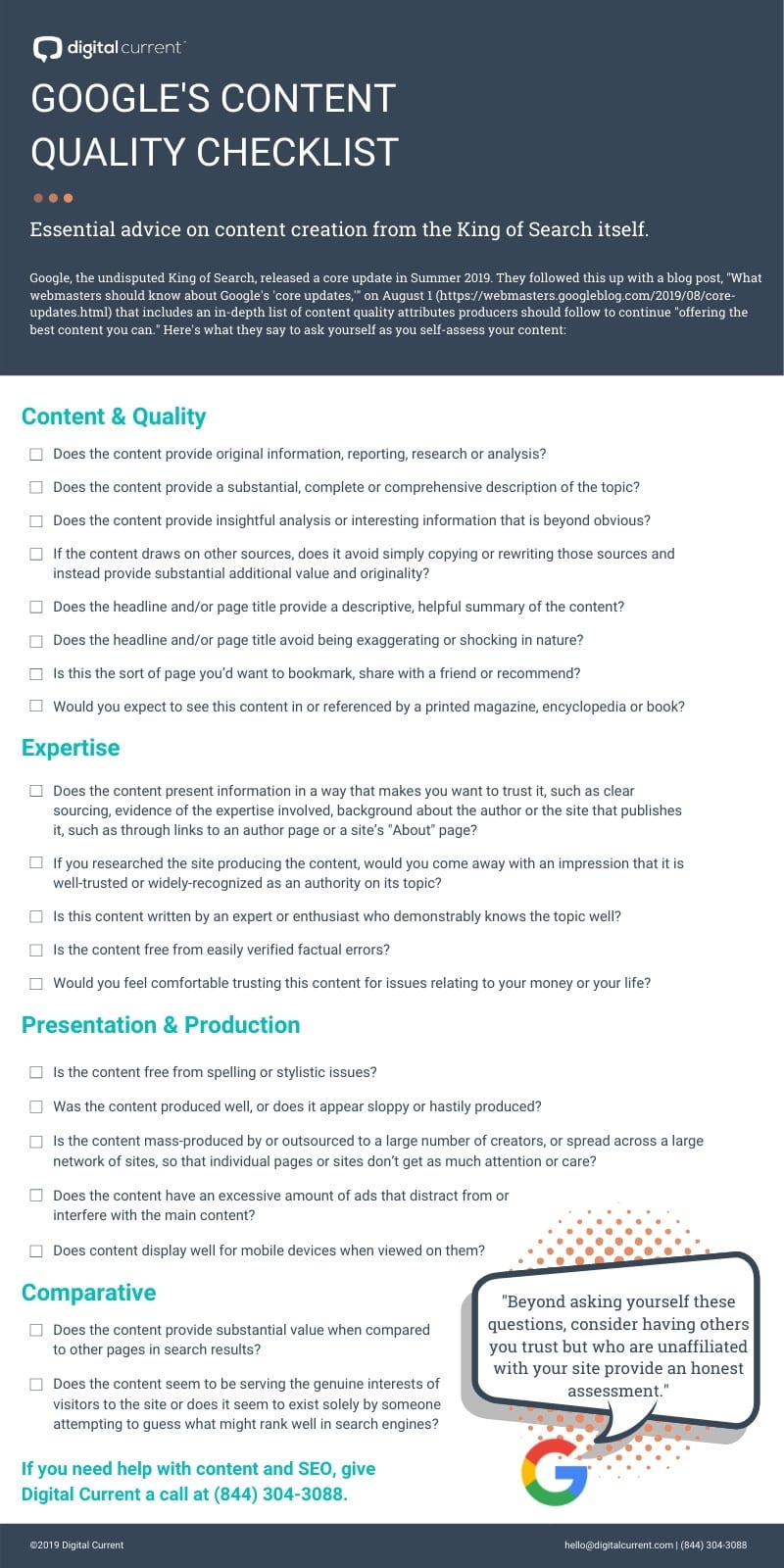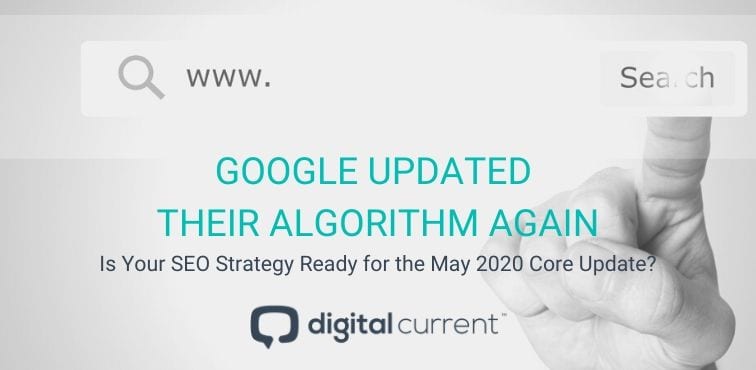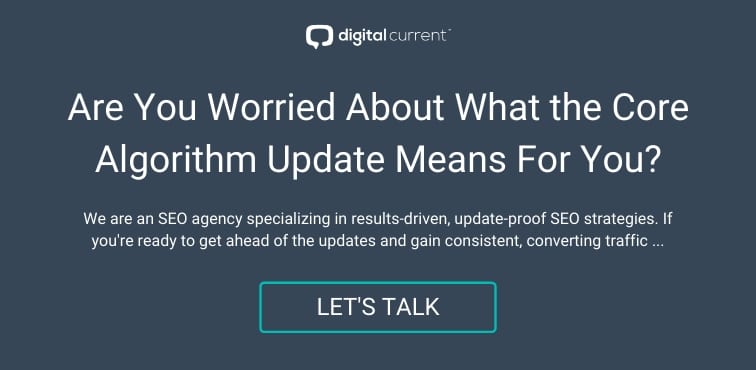May 2020 Core Update
Even in the midst of a global pandemic, seemingly nothing can stop the Google machine from turning.
On Monday, May 4, 2020, Google announced (via its SearchLiaision Twitter account) a “broad core algorithm update.”
The May 2020 Core Update is now rolling out live. As is typical with these updates, it will typically take about one to two weeks to fully roll out.
— Google SearchLiaison (@searchliaison) May 4, 2020
And so it was: the “May 2020 Core Update.”
COVID-19 has presented an interesting challenge to the search engine, and chances are the May 2020 update incorporates what Google has learned about changing search needs in this time of crisis.
In fact, there’s been a key update to Google’s news results in light of COVID-19.
Google Search has never seen as many searches for a single topic continue over a sustained period as is happening now with COVID-19. Many searches are for news about what’s happening in local areas, such as sheltering updates or the latest on testing. Here’s how we’re helping….
— Google SearchLiaison (@searchliaison) May 4, 2020
What we know for sure: this May 2020 Core Update will focus on better understanding search intent and serving up optimized results. So if your SEO strategy is customer-centric, you’ll be rewarded, but if you’re relying on old outsmart-the-search-engines tactics, you’re going to be left in the dust.
An experienced SEO agency will be able to help you distinguish between these two cases and plot out a strategy to combat any losses or capitalize on any gains. An experienced agency can also help you navigate and win consistently in the world of the ever-evolving algorithm.
Our approach is proven, customer-centric, and long-lasting. But I’m getting ahead of myself, first, let’s talk about how the algorithm has evolved in the past few years. (Or jump straight to the methodology).
*Disclosure: We only feature services and products we honestly believe in and our perspectives are genuinely our own expert perspective. This post may contain affiliate links from which we earn a small commission, at no additional cost to you.
A Look Back at Google’s Evolving Algorithm Strategy
Google has been working for years to better align results with user intent. The Medic Update in August 2018 was a significant signal that Google’s algorithm has taken a major step toward realizing the type of quality analysis recommended in the Search Quality Evaluator Guidelines. Many other updates have automated analyses or served the user, but the Medic Update unleashed RankBrain on content.
What’s RankBrain?
RankBrain is the machine-learning element of Google’s core algorithm. An unfathomable number of keywords, pages, clicks and other user interactions (presumably) have been training RankBrain to become a larger player in the keyword rankings. It allowed Google to test searcher’s intent at scale and now plays a more central role in the SERPs.
These types of user-centric algorithm updates are stacking up to be a multi-year trend as Google redefines its algorithm strategy.
Even looking back a few years, Map Packs dropped from seven results to three in 2015 to better serve mobile customers, who overtook desktop searches that same year. Fast-forward to 2018, the Speed Update, which rolled out a month prior to Medic, demoted sites that took too long to serve the user a page. And so the user-experience-centric trend grew more prominent.
There’s even evidence that the second post-Medic update (March 2019) reversed some ranking drops, implying the machine recognized an overcorrection from August. Plus, SEMRush shows a core algorithm update in every month from March through June 2019.
The machine moves faster than man. The Medic update was Google improving the YMYL (Your Money, Your Life) space, arguably the most consequential part of a user’s internet use. Users want to trust Google to return the information they need when they type in or say certain keywords, particularly when it comes to their money and health.
This machine-learning approach to content has lifted sites with no links to the first page and demoted large sites spun up for purposes other than serving the user. And that has emboldened Google to continue rolling this strategy out across all sectors of the internet.
That’s precisely why ranking predictions from random consultants with all caps in their LinkedIn bios are as reliable as a politician’s promise. Google simply isn’t recognizing the same aspects in calculating the rankings, so sites that aim to please Google, and not the user, are getting bumped down the SERPs.
Meet BERT
Google sent shockwaves through the SEO seas by releasing a named-algorithm update in November 2019, but BERT shouldn’t register as more than a ripple for your strategy.
BERT, or Bidirectional Encoder Representations from Transformers, is the latest iteration of Google’s natural language processing (NLP) capabilities.
Or, in short, Google’s reading comprehension graduated from middle school to high school.
Humans modify the meaning of words by the context of the sentence they’re used in. BERT allows Google to better understand searches by looking at the context of all the words together to serve more relevant content.
For example, “remove a nail” can have at least two vastly different meanings. By ensuring the latest machine-learning technology is looking for context, Google can make sure it’s not providing a hammer-related solution when you need a doctor’s phone number.
Plus, by improving Google’s understanding of how people talk and the interplay of their words conversationally, voice searches could ultimately be one of the biggest beneficiaries of this open-source technology.
Don’t view BERT as something ominous. This is good. BERT means that your targeted content strategy is more likely to succeed because this update affects 10%(!) of all searches by the right content.
January 2020 Core Algorithm Update
When Google rolled out a new Core Algorithm Update in January 2020, they, not unsurprisingly provided few details. They did indicate that it aligns with their other recent core algorithm updates, which are all aimed at providing searchers with the best possible experience.
Featured Snippets Deduplicating
On January 13-16, 2020, in their effort to constantly improve the search experience and keep more visitors on the search engine results page (SERP), they made a major algorithm update. At a high-level, if your site is part of the featured snippet on the page (otherwise known as position zero), you’ll no longer have any other page one rankings.
This information alone is enough to make any brand with a featured snippet and other positions on page one panicked and angry (after all, studies show that featured snippets have led to more than half of all Google searches ending without a click). And brands that were on page two are likely jumping on their desks and pumping their fists with joy. But, it’s a lot more complicated than that.
Not all search terms are created equal.
Think about the last thing you searched for. For me, it was how to spell a particular word that always trips me up. I had no intent to click through to the dictionary listing of that word, I simply needed to confirm that Google didn’t say “Did you mean?” and that the featured snippet definition aligned with what I was going for.
I had no reason to scroll beyond the featured snippet to see other listings, nor to click through on the featured snippet to read more. Competing for that term would be a waste of effort for brands to chance when it comes to me.
And it’s not just spelling blunders to which this applies. We’re constantly looking for quick answers and we’re nowhere near the buying cycle. So losing your additional SERP positions for terms like that, should not have a big impact on your brand.
There are, of course, many instances where that’s not the case. The searcher has intent to research deeply and potentially purchase. Those are the terms that you need to revisit your SEO strategy for.
However, since this update was announced, we’ve found it’s not impacting all industries. Some companies still have the featured snippet and positions one and two under their belts months later. So, before you react, work with an expert SEO agency on the best strategy.
How Does Digital Current Build Algorithm-Proof SEO Strategies?
You need a holistic understanding of a business’s goals, operations and desired keywords to plan the best mode of attack. Here’s how Digital Current treats old algorithm wounds and creates a healthy long-term plan for a thriving digital presence:
1. Campaign Kickoffs Focused on the Client’s Business
We jumpstart every new campaign with a deep dive into our client’s business. These kickoffs are our chance to learn everything remotely relevant, from who your customers are to how your products differ from each other and the competition.
Our primary focus during this process is understanding your business’s goals. This allows us to determine the proper KPIs for measuring success and remove doubt about which tactics are working.
These insights serve us well in developing strategies, allowing for lateral thinking that ties ideas together to holistically drive search, digital and business growth.
2. Audit, Audit, Audit
With a foundation of business knowledge, we turn to the website’s digital health and presence through a series of SEO and other digital marketing audits. These include:
Technical Audit
No website can thrive without a thorough examination of its technical structure. There are more than 180 issues we examine that can derail a site’s organic success no matter how great the content or thorough the keyword research.
We then build a plan of attack based on each obstacle’s potential impact versus the effort required. Whether it’s information architecture, a manual penalty or a spammy backlink profile, we set it straight so that our strategies are free to thrive.
Local Audit
Few areas of SEO have grown more in revenue over the past five years than the local organic channel. It’s imperative that all business with a local presence are following best practices both on- and off-site (Google My Business, citations, etc.) to compete.
Analytics Audit
There’s no point in identifying the right KPIs for a client if you’re not tracking them. A staple of our strategies includes an analytics audit that ensures crucial steps in the buyer’s journey are being monitored and reported.
Content Workshop, Personas and Audit
Keyword research can be rendered ineffective if the content doesn’t speak to the user’s needs in a voice that registers with the intended audience. Our content team works directly with your marketing department, sales staff, engineers and customers to find the right message to drive clicks, conversions, rankings and revenue.
Tie these audits together and what do you get? A clear understanding of what your users actually want and how you can best meet their needs.
3. Find Where Your Users Are Hanging Out
As we covered above, RankBrain uses machine learning to better understand what searchers are looking for when they use certain keywords.
If the algorithm determined that these users were looking for services, you’re going to find a Map Pack, local ads and a mix of directories (e.g., Yelp), lead-aggregation services (e.g., HomeAdvisor) and local landing pages. It’s also likely that those broad keywords that the big companies used to dominate have now been split into informational and local services, with little room for a generic homepage.
That’s why every keyword research project Digital Current conducts involves a SERP analysis. We dive past outdated tactics and raw numbers to find where our clients should live by looking at what type of results searchers are finding and your competitors are creating. Some of the questions we’re looking to answer include:
- Are ranking sites using deeper content to answer not just the original search but any follow-up questions?
- Are they using videos to better demonstrate how a product works or the right way to use a tool?
- Are image optimizations a place where we can get a leg up on the competition?
- Do we need to build more links to have a high enough authority to play in this space?
- What Schemas are the competitors using and what elements did they miss?
4. Target Those Users With the Right Optimized Content
Every digital marketer has inevitably been confronted with a tough question from a concerned client: “Why don’t I rank first for Keyword X anymore? This is a keyword that goes to the core competency of my business. How are we so far down (or off!) the first page?”
It can be uncomfortable, but there’s often a learning curve that hopefully your SERP analysis handled. And if we’ve done our job, the client will understand that those may not be the keywords they really need. Or perhaps it’s a matter of showing that ranking your homepage for a broad keyword with a massive search volume isn’t the way to compete. Rather, there may be more opportunity in a lesser-volume keyword for which you can gain greater visibility.
Keywords with a local intent have crept steadily upwards for years and make up just less than half of all searches. Those searches happen primarily on a mobile device dominated by a Map Pack. So not only do you need a mobile strategy, but your Google My Business (GMB) accounts need to be updated and supported by accurate citations, too.
Clients may not notice their page on the shrinking organic SERP, but they’ll notice the bump in revenue, no doubt.
Case in point, one enterprise client started appropriating a third of its budget for local SEO just over a year ago, driving an additional estimated $13.5 million in revenue off calls alone. These calls won’t show up in your organic traffic, so it’s imperative to track these actions using GMB Insights or other call-tracking platforms.
Plus, the reality is some local keywords are no longer winnable for companies. People love those top 10 lists of the best dry cleaners in their area. Those will always fluctuate near the top and often require a three-pronged approach to compete against, including the above-mentioned GMB, a local landing page and often a page with informative content to help users who may not become buyers at the same rate.
Finally, Google has made it clear it wants to keep more users on its own SERPs. Digital marketers and businesses must shift strategies to be where the user is converting, and that often means playing on Google’s field. Dinner reservations, travel plans and even food orders can be completed from end to end without ever leaving a Google domain. Clients need to make sure they’re up to par with Google’s latest offerings and requirements.

Where Do We Go From Here?
SEO isn’t dead — it’s evolving. And your strategy needs to evolve, too.
Short-term strategies focused on page optimizations with a few links will only get you so far.
Quick wins are still possible, but sustained success requires a strategy upgrade to survive algorithm updates.
We understand where Google has been moving toward (they’ve been telling us) and where the search engine is going. Our in-depth analysis goes past keywords, search metrics and word counts to determine how to satisfy a searcher’s intent. That’s how you win in Google’s post-Medic Update world.
We’re ready to roll up our sleeves and develop a strategy for you.



